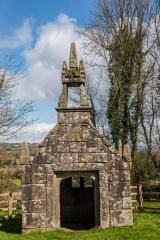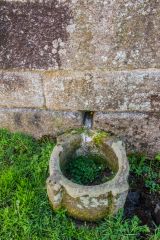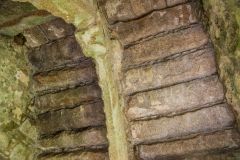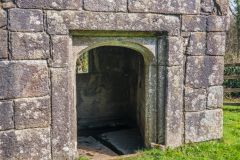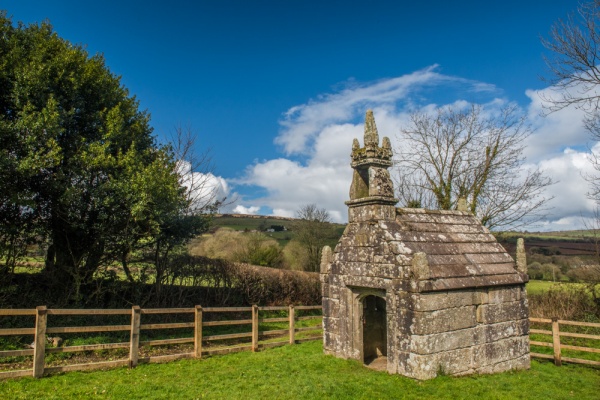
A holy well on the outskirts of Callington and close to Cotehele House. Dupath Well is probably medieval, though it may go back much further. The well is thought to have been a destination for pilgrims suffering from skin diseases and/or whooping cough. Within the well house is an immersion pool where sufferers could bathe in the healing waters.
The water emerges into a well house built in around 1510. This is a rectangular building built of very large blocks of stone, topped with a very rough turret. The well house roof is made of very large stone blocks overlapping to form a corbelled dome. Beside the well house is a circular trough, also medieval, to collect the water.
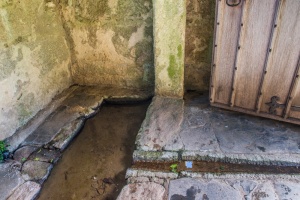
The land on which the well is located was owned by the Augustinian canons of St Germans Priory from 1432 until the priory was dissolved in 1539 by Henry VIII. It seems reasonable to assume that the priory may have had a hand in the building of the well head.
Tradition says that a 15th-century chapel dedicated to St Ethelred stood near the well. A license to build a chapel was granted to Bishop Stafford in 1405, and carved stones have been ploughed up nearby, so the tradition may be true.
A further legend says that the well stands near the site of the place where two Saxon chieftains fought a famous duel to the death.
Visiting
Getting to Dupath is half the fun. We came from the east, down very narrow lanes, hoping we didn't meet a vehicle coming the other way. What we should have done is to approach from the west, off the A390 or A388, onto Dupath Lane, then branched off onto the lane leading to Dupath Farm. There is a very small parking area just inside the farmyard, and a road leads downhill another 50 yards to the holy well.
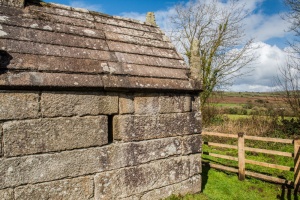
When we arrived, a family group including a very elderly man were just leaving. I got the distinct impression that the man had been visiting the holy well for its healing properties, perhaps even bathing in the immersion pool. It is fascinating to see the well still being used for healing after hundreds, perhaps thousands, of years.
The location is absolutely idyllic; the well looks out over the valley below, and the sense of peace is tangible. The ground below the well house was damp, so waterproof footwear is a good idea.
The interior of the well house is extremely basic, essentially empty save for a small channel running down the centre of the building, emptying into the immersion pool. What really struck me was the corbelled roof, made with massive slabs of heavy stone. How the medieval builders managed to lift the stones into place is remarkable.
Dupath is one of those magical places that will live long in the memory, a real medieval treasure. The well house is open at any reasonable time, but do please respect the privacy of the people who live at the farm.
About Dupath Well
Address: Callington,
Cornwall,
England, PL17 8AD
Attraction Type: Historic Building
Location: 1 mile east of Callington. Accessible by footpath, signposted 'Dupath Well Chapel'. Open access.
Website: Dupath Well
English Heritage - see also: English Heritage memberships (official website)
Location
map
OS: SX373693
Photo Credit: David Ross and Britain Express
Opening Details: Open access site, usually accessible at any reasonable time
HERITAGE
 We've 'tagged' this attraction information to help you find related historic attractions and learn more about major time periods mentioned.
We've 'tagged' this attraction information to help you find related historic attractions and learn more about major time periods mentioned.
Historic Time Periods:
Find other attractions tagged with:
15th century (Time Period) - Augustinian (Historical Reference) - Ethelred (Person) - Henry VIII (Person) - holy well (Historical Reference) - Medieval (Time Period) - Saxon (Time Period) -
NEARBY HISTORIC ATTRACTIONS
Heritage Rated from 1- 5 (low to exceptional) on historic interest
Cotehele Mill - 2.8 miles (Historic Building) ![]()
Cotehele - 3.1 miles (Historic House) ![]()
Cotehele, Chapel in the Woods - 3.2 miles (Historic Church) ![]()
Ken-Caro Garden - 3.7 miles (Garden) ![]()
Morwellham Quay - 4.4 miles (Museum) ![]()
Bere Ferrers, St Andrews Church - 6.4 miles (Historic Church) ![]()
Denham Bridge - 6.5 miles (Historic Building) ![]()
Trethevy Quoit - 7 miles (Prehistoric Site) ![]()
Nearest Holiday Cottages to Dupath Well:
Callington, Cornwall
Sleeps: 6
Stay from: £303 - 2099
More self catering near Dupath Well
